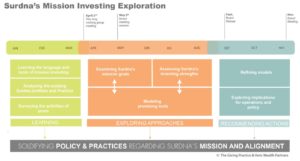Back

Blog
Surdna Foundation Latest to Redirect Assets into Impact Investments for Social Good
A few months ago, we featured a story about how the Commonwealth of Pennsylvania has created a $100 million impact investing initiative redirecting funds into investment products that will not only provide monetary return, but support affordable housing, small businesses, infrastructure projects, and health and educational facilities. New York City, Washington, D.C. and the Commonwealth of Massachusetts all have similar initiatives, albeit at different scales.
These efforts are certainly to be heralded—but cities and states aren’t going at it alone.
A growing roster of foundations is also getting into the business of impact investing. This past February, the Surdna Foundation, a New York City-based family foundation, announced that it would allocate $100 million of its $1 billion endowment to impact investments.

Impact investing aims to marry the goals of generating competitive financial returns while creating measureable, beneficial social or environmental impacts. Impact investors actively seek to place capital in businesses, nonprofits and funds that can harness the positive power of enterprise.
For the Surdna Foundation, this means dedicating $18 million to program-related investments in its three core program areas: strong local economies, sustainable environments, and thriving cultures. The remaining $82 million will be mission-related investments that share the foundation’s values but aren’t as closely tied to its grant programs.
Surdna has already allocated $5 million to a venture capital fund that invests in companies that promote social and environmental impact. Another $700,000 was invested in the form of a four-year loan to BOC Capital Corp., a New York City-based CDFI and affiliate of the Business Outreach Center (BOC) Network. The low-interest loan helped to recapitalize a $3.5 million loan program offered in partnership with Goldman Sachs 10,000 Small Businesses that helps connect women- and minority-owned businesses in the city’s construction industry with the short-term capital they need to complete subcontracts.
Surdna’s Director of Impact Investing, Shuaib Siddiqui, makes it clear these investments are an experiment. “We’re carving out this $100 million pool of capital to figure it out: Can we continue to meet the needs of the foundation, our commitment to grant making, but also invest in a mission-aligned way and generate the returns we need to generate?”
Impact investing isn’t a new concept, but it is one that has gained momentum in recent years.
Coinciding with its impact investing announcement, Surdna released a report “Mapping the Journey to Impact Investing,” which acknowledges that the foundation had been exploring the idea since the early 2000s but struggled to gain traction among decision makers. When the foundation realigned its mission in 2008 to include a more concentrated focus on justice, it created an opportunity to revive the conversation. In truth, Surdna says it wasn’t until 2014 that it really took another hard look at impact investing. The foundation (with the help of a working group and team of consultants) spent two years investigating the best route forward before agreeing to allocate 10 percent of its total endowment to impact investments.
Surdna is just the latest foundation to enter the realm of impact investing. Since 2014, the McKnight Foundation has been allocating 10 percent of its $2 billion endowment toward investments that align with its mission. In 2012, the F.B. Heron Foundation announced an ambitious goal: by 2017, the foundation would move its entire $270 million endowment into impact investments that fit with the organization’s mission of “helping people and communities help themselves out of poverty.” The foundation met its goal this past December, ahead of schedule.
It is likely that more foundations will follow suit as the number of success stories grow.
Surdna’s “Mapping the Journey to Impact Investing” report will be an incredibly useful resource for those who do. The report includes an “Impact Investing Road Atlas” that follows the timeline and thought process used throughout Surdna’s two-year due diligence process. It includes valuable insights from working group members, and offers important lessons learned that can inform other foundations embarking on a similar journey of their own (e.g., start with a framework; create a hypothetical model; match the process to your culture; seek out diverse viewpoints).
There’s still a long way to go with impact investing. Existing initiatives—whether at the city- and state-level or through foundations—are just the tip of the iceberg, and the private sector certainly has to play a bigger role As more players get into the impact investing game, we are excited to learn more about how it can create social, economic and environmental impact in the years to come.
